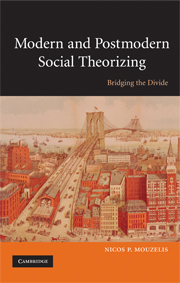Book contents
- Frontmatter
- Contents
- List of figures
- Acknowledgements
- Introduction
- Part I The theoretical background: the development of the agency–structure problematic
- Part II Parsonian and post-Parsonian developments
- Part III Agency and structure: reworking some basic conceptual tools
- Part IV Bridges between modern and late/postmodern theorizing
- Part V Towards a non-essentialist holism
- 13 Grand narratives: contextless and context-sensitive theories
- 14 The actor–structure dimension: anti-conflationist holism
- 15 The micro–macro dimension: anti-essentialist holism
- 16 The inter-institutional dimension: beyond economism and culturalism
- Instead of Conclusion: Twelve rules for the construction of an open-ended holistic paradigm
- Appendix: In defence of ‘grand’ historical sociology
- References
- Index
14 - The actor–structure dimension: anti-conflationist holism
Published online by Cambridge University Press: 05 June 2012
- Frontmatter
- Contents
- List of figures
- Acknowledgements
- Introduction
- Part I The theoretical background: the development of the agency–structure problematic
- Part II Parsonian and post-Parsonian developments
- Part III Agency and structure: reworking some basic conceptual tools
- Part IV Bridges between modern and late/postmodern theorizing
- Part V Towards a non-essentialist holism
- 13 Grand narratives: contextless and context-sensitive theories
- 14 The actor–structure dimension: anti-conflationist holism
- 15 The micro–macro dimension: anti-essentialist holism
- 16 The inter-institutional dimension: beyond economism and culturalism
- Instead of Conclusion: Twelve rules for the construction of an open-ended holistic paradigm
- Appendix: In defence of ‘grand’ historical sociology
- References
- Index
Summary
Introduction
Inclusiveness in the action–structure, or action–system, dimension means that a holistic framework should encourage the researcher to look at social phenomena both from an actor's ‘internalist’ perspective and from a systemic ‘externalist’ one. This means, in Lockwood's well-established terminology, that a social whole should be studied from both a social-integration and a system-integration perspective: both as a figuration of actors related to each other in conflictual and/or co-operative terms, and as a system of interrelated ‘parts’ (or institutional subsystems) logically compatible or incompatible with each other (see chapter 6). Any attempt to disregard the imperative of combining in a balanced fashion an action/internalist and a system/externalist perspective leads to either a trivial or a distorted analysis of the phenomena under investigation. An open holistic framework, as far as the action–system problematic is concerned, does not only reject the exclusive focus on one of the two perspectives, it also rejects attempts aiming at:
– the a priori subordination, or the derivation of the one perspective from the other (as in Parsons' oversystemic middle and late work – see chapter 1, section 1);
– the ‘transcendence’ of the action–system distinction via various conflationist strategies (as in Giddens' structuration theory – see chapter 7);
– the abolition of the action–system distinction altogether (as in various structuralist and post-structuralist approaches – see chapter 1, sections 4–6).
- Type
- Chapter
- Information
- Modern and Postmodern Social TheorizingBridging the Divide, pp. 225 - 236Publisher: Cambridge University PressPrint publication year: 2008



